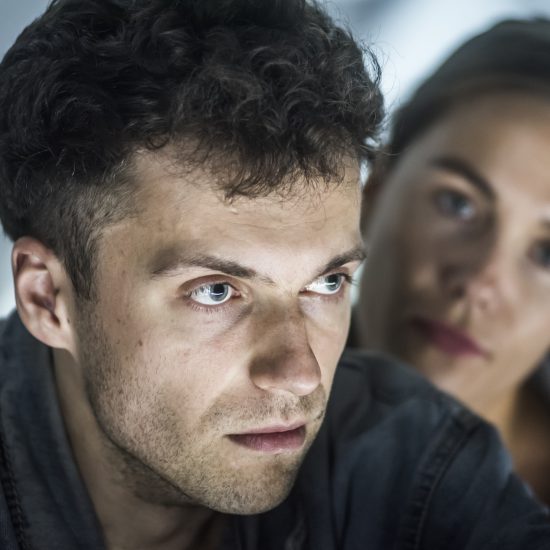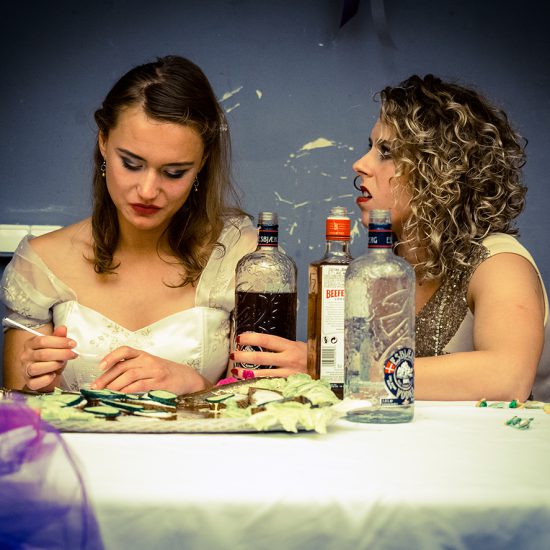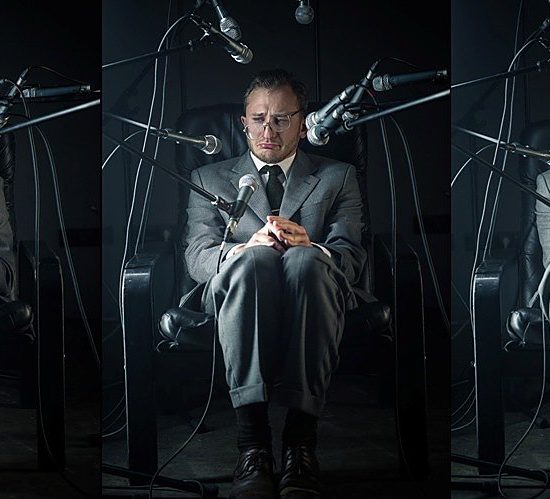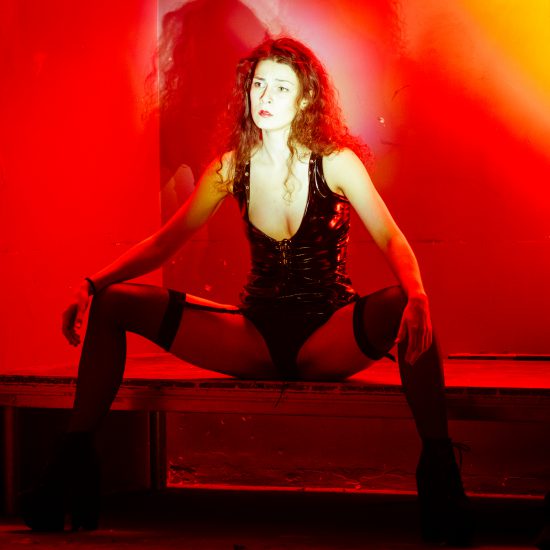Repetitions of Oedipus the King (1)
Oedipus the King (Oedipus Rex) associates to us with stiff and distant antiquity, antiquity which is both foreign and close, which is daily coming across as if it was the capital of pseudodoric column in Daukantas square or the patterns on Turkish sweaters that you can buy in Gariunai or the part of Freud’s psychoanalytic territory. Art’s world was constantly recurring to Oedipus’ drama; the play was staged and directed times out of, in spite of whole insidiousness hidden in Sophocles’ tragedy’s plot. How to find adequate relation with culture, which, on one hand, today is rooted in commonness and which, on the other hand, becomes more and more alien and unrecognizable to us? It is always right here and somehow absent at the same time. We constantly get it as a product but not as a relation itself anymore. Its aesthetics do not affect us in unexpected way. We got used somehow to all what was Greek. All the greatest creators felt this kind of ambiguous situation harbouring in itself that echo of Sphinxes riddle set in the mythic times. The clue into antiquity of P. P. Pasolini was drastic and artistic effectible at the same time. In his book Rules of the Illusion he describes some circumstances of the creative process that predetermined his way of antique’s interpretation. “The crucial difference between Oedipus the King and my other films was based on the fact that current film was some kind of an autobiography, while others were not of that kind; even if they had some autobiographical elements inside these elements appeared there accidentally and were poor and indirect. In Oedipus the King I told my own story of Oedipous complex; that kid whom we saw in prologue is exactly me; his father is my father, an old infantry officer; and mam the teacher is my mam. I tell my mythologized life story, which is made mythological exactly by Oedipus’ legend” (P.P.Pasolini. Le regole di un’illusione. Roma, 1991. P. 155-156). Although somewhat further director remarks, that personal experience used in the film was not alive and forcible any more, that he regards it rather with retrospective glance than with urgent passion, the standpoint made in the light of personal feelings determine very concrete relation of creator and his spectators with this work. It should be admitted that such a stand is not very original from the theoretical point of view; however, it is also obvious that such kind of originality has not been on a target at all. Important thing here, as it was already mentioned, is the poetic personification which leads Oedipus the King to be regarded not as a simple story born in twilights of western culture, a story representing the primitive explanation of human relation with gods, his own destiny and knowledge of himself, but as an urgent moment of human experience that appeared to the space of artistic interpretation turns into a shocking poetry.
Even ancient Greeks themselves haven’t had homogeneous approach to a myth. In the archaean Homer’s age much stronger belief in reality of the myths plot has flourished, while during the other ages that belief faded, turning into sophistic unbelief in myth or platonic allegorizing of the myth. Though it is an important step to point up that myth kept an extremely significant and peculiar role in the space of theatrical action. Used by the poets as a “row material” myth realized itself as a part of religious ritual in theatre. Spectator might urgently meet the mythical reality here. Namely the talent of drama’s writers acted as a cathalizator that in part ensure the intensity of the religious experience for aesthetic Greeks, what ever oddly does it take. Apparently, Aristotle mentions catharsis concept, – state of sense’s rectify and relation presently arising from the space of dramatic process, – when speaking about euphoric moment of that meeting. Therefore being recurred once again to antique themes and thinking of a new Oedipus the King production, one may suggest cathartic state as a main guide that should lead to authentic interpretation of antique tragedy. In that case, importance to highly attentive consideration appears for those odd nature’s relations that bore between the actors and spectators in Athens Dionysus’ theatre rather than precise and erudite repetition or elucidation of the antique drama’s meanings, i.e. culturally retrospective look at the Sophocles’ text.
In part that trend has been forgotten in the present theatre. The activation of catharsis is absolutely unnecessary in modern productions, although it would be to bold to assert that this aspiration doesn’t exist at all. Such situation is partly determined by notable change of theatre’s role in the present world. Today next to each other coexists both having deep intellectual charge performances and damaging substance or appealing to form efficacy post-modern productions and both has an equal rights. In such situation, when the pluralism of expression’s means and opportunity’s to artistic self-realization is flourishing, cathartic states becomes rather an accidental result of theatrical process than programme attitude, according to which one might determine aesthetic-artistic quality of the performance.
So, while a new production of the Antique myth is being set to stage, the question of a status of the theatre by itself may emerge. In fact, attitude to the question what is the theatre? or at least to the question what’s happening in the theatre of Antique myth today? should determine the relation both with that certain Sophocles’ drama and with antiquity in general. Forestalling the events it should be emphasised that we do not intend to present any phrased or resultful answer in spite of such radical illumination of production’s process may bring to erroneous poliphony of opportunities. Production process of the Oedipus the King and urgent acting of an actors is the answer by it self. We are starting our journey guided by that question, we are giving way to its mad adventure’s temptation even if we understand that the foundation which we are stiring may bury us under its ruins. On the other hand, right here we brightly realise our magic position, the position we are awarded by the theatre as ars artium (thus it was regarded by Aristoteles or Nietzsche) itself. We come to the space where the vanity of properties and the tricks of reality clashes, where the pure posibility collides with the devotion to the amazing contingency. We give theatre’s name for the opposition of reality, however at the same time it remains the most genuine art of the arts, its ontology is ephemeral and it must simply be perceptible as radically present, it depends on the actors’ hearts beating and on the mood of the spectators.
Right here we are faced with several possible perspectives of the interpretation. The first one – effort for restoration of the antiquity. There are plenty of such reconstructive examples. Here we could mention Oedipus the King by Miltinis, Odysea by Konchalovsky, Holywood production of Gladiator, which is striving to reach the virtual echo of the Marcus Aurelius’ epoque. Probably in such perspective the brilliant Herculeses and Xennas that we can see every week on TV could also be recognisible. Although the latter ones should deserve plenty of reproaches from the experts of antiquity through the false restoration, still those could be compared with the mentioned works in a light of the common search for the reconstruction of antiquity’s factualness, i.e. one may say that restoration of reality here is understood as restoration of realia. Though transgression from the available antique plot is quite frequent here, the main attention is always riveted to the reconstruction of the propertical surroundings. While you observe such works you may feel as if you found yourself in the museum of Rumsiskes or in the parade of the stuffed animals. Here we meet with the ethnographic surroundings, the artificially restored or even – constructed type of the world, unnatural space of aquarium. Energetics of such art lies in the simulation of reality. The reality which does not exist and can not exist. And in this respect the reality is radically foreign. Although that confrontation with the production of such foreign reality also has some power. That is the power, which appeals to the natural human curiosity, the power, which may compose into one the African folk dances, the delicate recipies of Laos’ kitchen, the volcanos of the Andes, the dravings of the primitive men in the caves, the latest news of the UFOs, etc. If we try hard we can also place Oedipus the King here. However, the attempt to restore the antique myth in the ‘precise as far as it is posible’ way is condemned to remain the product which is absolutelly strange for the spectator’s experiece. It may fascinate educated intellectuals or satsify the curiosity of a little bit more unfanciful audience, still it hardly shakes the spectator’s existence, interferres into his field of life, or appeals dinamically to the senses that are being experieced.
Second possibility – to see the text of Sophocles’ drama as the pretext. That is the way how, for instance, the antiquity is treated by Warlikowsky in his Bacchantes. Historical difference between the epoches is reduced to insignificant circumstances; the drama is transformed into the present without raising a question of how to overcome the trensience of the past. There the pure acctualisation rules over and the work of the ancient Greek becomes an introduction to the important matters of the present. There everything is clear and understandable, we can see on the stage the continuation of reality, which hangs over the window: the same clothes, the same music, the same problems. It could be said that such kind of standpoint comes from the distrustfulness to the semantic complex of the facts of distant culture when the archaic eviroment doesn’t have its’ notional activity anymore. The electric teapot is more affectible than the Greek amphora. Its’ semantic charge is obvious and swift by itself, while the amphora risks to be drown in the passiveness of the obscure identity and the unactual meaning. For the same reasons the sound of the iambic trimeter becomes similar to the archeological remnant, while the beat of hip-hop gives the experience of the clear and close enviroment immediately.
It’s obvious that both interpretative perspectives juggles with the objects. In the first case the stage is filled with the ancient and museum ones; in the second case the ancient objects are substituted with the modern ones. However, the things start to live their own lives only when they are set free from the history and the culture by the dynamics of the intention directed at the thing. The importance of such dynamics is pointed out by Gilles Deleuze, a postmodern thinker, who revived the philosophy’s relation with the cinema and the theatre. He says: “Theatre is real movement, and it extracts real movement from all the arts it employs. This is what we are told: this movement, the essence and the interiority of movement, is not opposition, not mediation, but repetition. […] When we say, on the contrary, that movement is repetition and that this is our true theatre, we are not speaking of the effort of the actor who ‘repeats’ becouse he has not yet learned the part. We have in mind the theatrical space, the emptiness of that space, and the manner in which it is filled and determined by the signs and masks through which the actor plays a role, which plays other roles; we think of how repetition is woven from one distinctive point to another, including the differences within itself. […] The theatre of repetition is opposed to the theatre of representation, just as movement is opposed to the concept and to representation which refers it back to the concept. In the theatre of repetition, we experience pure forces, dynamic lines in space which act without intermediary upon the spirit, and link it directly with nature and history, with a language which speaks before words, with gestures which develop before organised bodies, with masks before faces, with spectres and phantoms before characters – the whole apparatus of repetition as a ‘terrible power’.” (G. Deleuze. Difference and Repetition. New York, 1994. P. 10). This reiteration or repetition (i.e. répétition) in the works of the philosopher becomes a descriptive word of extreme importance. For Deleuze’s repetition is unique, the only, and concrete. The repetition receives its’ charge from the things that are being repeated, and that what is being repeated gains sense of its’ repetition. Repetition isn’t production of just one more identical copy. It is rather the relation which becomes actualised. In such perspective important is not the attachement to the space, determined by things which belong to certain period, but “awakening” of the things themselves. Relation here doesn’t play the role of mediator that would connect that what was being directed at with that to what it was directed. Such is traditional concept of Aristotel’s relation when in order to maintain the relation two poles are required, i.e. two things, whose positioning with one another is described by their relation. Here on the contrary we are faced with relation in itself. The relation as movement that does not depend on what it is points at and to what it points. It does not explain any attitude to one another. It rather is itself as ephemeral and, at the same time permanent, unbeing way of being. The relation is act in exactly same way as repetition is act, too.
Specifics of repetition that exposes the moment of surmount over the epochs can be found in relation between psychoanalitical school and myth. It is not in vain that Levi-Strauss, when he proposes “to describe every myth as whole of their variants”, supposes that “Freud like Sophocles can be concidered as a source for one of the myths of Oedipus” (C.Levi-Strauss. Mitu struktura In Mitologija siandien.Vilnius, 1996. P.61). When we trustfully enter the office of psychoanalist we find ourselves in creative and unique situation of repetition – transformed and personalysed myth penetrates to the world of deepest structures of us as concrete existing beings.
Talking further of relation between myth and reality or actualisation of such relation in the modern times we’d like to recollect person who is poorly known within the wide theatrical context. In the late 1970s eccentric youth Mauro Biancanotte gathered the group of the like-minded persons that carried out the shocking project of “reality’s theatre”. The driving axle of that project lied to the play on mixed realities: performing starts at the real life situations (for example, modelling of drastic situations at the subway’s stations, in waiting-rooms at the functionary’s offices or simply in the street with passers-by, etc.) or fulfilling real and brutally astonishing actions during the theatrical performance of drama. In 1972 Biancanotte produced Oedipus the King, although due to discontent of the theatrical functionaries he didn’t manage to find the stage for the performance: the real pricking out of the eyes would be culmination of the play. This Italian representative of advance-guard was far from avoiding of the physical violence and evident pornography while staging other performances. He was even convicted of his drastic deeds (he has injured an actor during the rehearsal) and was kept in the prison for the period of one year. In 1982 Biancanotte was found hung himself in his apartment in Rome. Highly original and at the same time fragmental, hardly understandable and widely interpreted conception of art was his inheritance that reached us in dozens of text’s fragments (those together with quite wide introduction were published by Ettore De Amicis, the best Mauro Biancanotte’s friend in 1993). Such original view of both antique art and theatre on the whole determined that certain artistic principles of Italian director were influential to our version of Oedipus the King. We feel obliged to the odd creator and therefore we are going to present partial translation of the some texts and more detailed narration on his life and creative work.
Translation by Gediminas Pulokas



